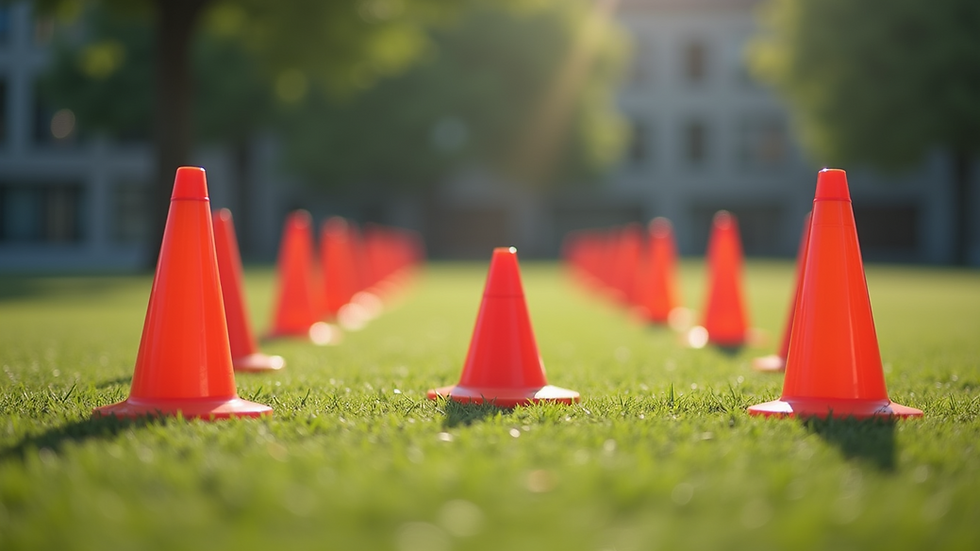ILLINOIS AGILITY TEST SPORT PERFORMANCE PROTOCOL
- Moran Sciamama-Saghiv
- Sep 3
- 4 min read
The Illinois Agility Test is a widely recognized assessment tool used to measure an individual's agility, speed, and overall athletic performance. This test is particularly popular in various sports and physical education programs, as it provides valuable insights into an athlete's ability to change direction quickly and efficiently. In this blog post, you will learn about the Illinois Agility Test, its significance, how to conduct it, and tips for improving your agility.
What is the Illinois Agility Test?
The Illinois Agility Test is a standardized test designed to evaluate an athlete's agility and speed. It involves a series of movements that require quick changes in direction, which are essential skills in many sports, including basketball, soccer, and football. The test is typically performed on a flat surface, such as a gymnasium floor or an outdoor track, and requires minimal equipment.
The test consists of a specific course layout, which includes cones or markers placed in a designated pattern. The athlete must navigate through the course as quickly as possible, demonstrating their ability to accelerate, decelerate, and change direction effectively.
Importance of Agility in Sports
Agility is a critical component of athletic performance. It allows athletes to respond quickly to dynamic situations during competition, such as evading opponents, making sharp turns, and executing complex movements. Improved agility can lead to better performance in various sports, as it enhances an athlete's ability to maintain control and balance while moving at high speeds.
Moreover, agility training can help reduce the risk of injuries by improving coordination and stability. Athletes who possess strong agility skills are often more adept at avoiding collisions and falls, which can lead to fewer injuries during training and competition.
How to Conduct the Illinois Agility Test
Conducting the Illinois Agility Test is straightforward. Follow these steps to ensure an accurate assessment of agility:
Equipment Needed
Cones or markers: You will need at least 8 cones to set up the course.
Measuring tape: To measure the distances accurately.
Stopwatch: To time the athlete's performance.
Flat surface: A gymnasium floor or outdoor track is ideal.
Setting Up the Course
Layout: Arrange the cones in a rectangular shape, with the following dimensions:
Place 4 cones in a straight line, spaced 3.3 meters apart.
At each end of this line, place 2 additional cones, 5 meters away from the center line, creating a total of 8 cones.
Mark the Start and Finish: Designate a starting point at one end of the course and a finish line at the opposite end.
Performing the Test
Warm-Up: Ensure the athlete performs a proper warm-up to prevent injuries.
Starting Position: The athlete should start lying face down behind the starting line.
Timing: On the command "Go," the athlete will get up and sprint to the first cone, navigate through the course, and return to the starting point.
Recording Time: Use the stopwatch to record the time taken to complete the course.
Repeat: It is recommended to conduct the test at least twice, taking the best time for accuracy.

Scoring the Test
The time recorded during the Illinois Agility Test is the primary measure of performance. The faster the time, the better the agility score.
Normative Data
While individual performance can vary based on age, gender, and sport, general normative data can provide a benchmark for evaluating results. For example, elite athletes may complete the test in under 15 seconds, while recreational athletes may take longer.
Tips for Improving Agility
Improving agility requires a combination of specific training exercises, drills, and techniques. Here are some effective strategies to enhance your agility:
1. Plyometric Exercises
Plyometric exercises, such as box jumps and lateral hops, can significantly improve your explosive power and agility. These exercises train your muscles to generate force quickly, which is essential for rapid movements.
2. Ladder Drills
Agility ladders are excellent tools for developing foot speed and coordination. Incorporate ladder drills into your training routine to enhance your ability to change direction quickly.
3. Cone Drills
Set up cones in various patterns and practice sprinting, shuffling, and backpedaling around them. This will help you develop the necessary skills to navigate through obstacles effectively.
4. Strength Training
Building strength in your legs and core can improve your overall stability and control during dynamic movements. Focus on exercises that target these areas, such as squats, lunges, and deadlifts.
5. Flexibility Training
Incorporate stretching and flexibility exercises into your routine to improve your range of motion. Greater flexibility can enhance your ability to perform quick movements without injury.

Common Mistakes to Avoid
When conducting the Illinois Agility Test or training for agility, it's essential to avoid common pitfalls that can hinder performance:
1. Poor Warm-Up
Neglecting to warm up properly can lead to injuries and suboptimal performance. Always include dynamic stretches and light cardio before starting the test or agility drills.
2. Incorrect Technique
Ensure that you maintain proper form during the test and training exercises. Poor technique can lead to inefficiencies and increase the risk of injury.
3. Inconsistent Practice
Agility is a skill that requires consistent practice. Make agility training a regular part of your workout routine to see significant improvements.
4. Ignoring Recovery
Allow adequate time for recovery between training sessions. Overtraining can lead to fatigue and increase the risk of injuries.
Conclusion
The Illinois Agility Test is a valuable tool for assessing and improving agility, a crucial skill for athletes in various sports. By understanding the test's significance, learning how to conduct it, and implementing effective training strategies, you can enhance your agility and overall athletic performance.
Remember, agility is not just about speed; it's about control, balance, and the ability to respond quickly to changing situations. By incorporating the tips and techniques discussed in this post, you can work towards becoming a more agile and versatile athlete.

Services by Dr. Moran Sciamama-Saghiv:





Comments